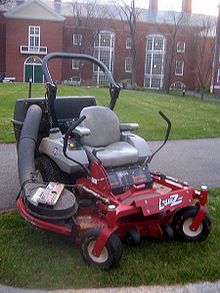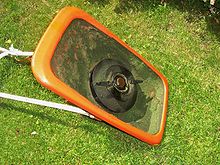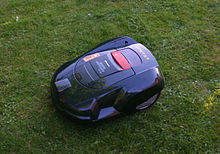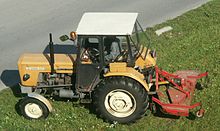Types of lawn mowers
Other notable types
Riding mowers (U.S. and Canada) or ride-on mowers (U.K. and Canada) are a popular alternative for large lawns. The operator is provided with a seat and controls on the mower and literally rides on the machine. Most use the horizontal rotating blade system, though usually with multiple blades. A common form of ride-on mower is the lawn tractor. These are usually designed to resemble a smallagricultural tractor, with the cutting deck mounted amidships between the front and rear axles.
The drives for these mowers are in several categories. The most common transmission for tractors is a manual transmission. The second most common transmission type is a form of continuously variable transmission called the hydrostatic transmission. These transmissions take several forms, from pumps driving separate motors, which may incorporate a gear reduction, to fully integrated units containing a pump, motor and gear reduction. Hydrostatic transmissions are more expensive than mechanical transmissions but they are easier to use and can transmit greater torque to the wheels as compared to a typical mechanical transmission. The least common drive type, and the most expensive, is electric.
There have been a number of attempts to replace hydrostatic transmissions with a lower cost alternative, but these attempts, which include variable belt types (e.g., MTD's Auto Drive) and toroidal, have various performance or perception problems that has caused their market life to be short or their market penetration to be limited.
Riding lawnmowers can often mount other devices such as rototillers/rotavators, snowplows, snowblowers, yard vacuums, occasionally even front buckets or fork-lift tines.

A zero-turn mower
The deck of a rotary mower is typically made of steel. Lighter steel is used on less expensive models, and heavier steel on more expensive models for durability. Other deck materials include aluminum, which does not rust and is a staple of higher priced mowers, and hard composite plastic, which does not rust and is lighter and less expensive than aluminum. Electric mowers typically have a plastic deck.
Riding mowers typically have an opening in the side or rear of the housing where the cut grass is expelled. Some have a grass catcher attachment at the opening to bag the grass clippings.
Hover mowers are powered rotary push lawn mowers that use an impeller above the spinning blades to drive air downwards, thereby creating an air cushion that lifts the mower above the ground. The operator can then easily move the mower as it floats over the grass. Hover mowers are necessarily light in order to achieve the air cushion and typically have plastic bodies with an electric motor. The most significant downside, however, is the cumbersome usability in rough terrain or on the edges of lawns, as the lifting air-cushion is destroyed by wide gaps between the chassis and the ground. Hover mowers are built to operate on steep slopes, waterfronts, and high-weeded areas, so they are often used by golf courses and commercial landscapers. Grass collection is often available, but can be poor in some models. The quality of cut can be inferior if the grass is pushed away from the blade by the cushion of air.

Hover mower (underside view).
A robotic mower is contained by a border wire around the lawn that defines the area to be mowed. The robot uses this wire to locate the boundary of the area to be trimmed and in some cases to locate a recharging dock. Robotic mowers are capable of maintaining up to 5 acres (20,000 m2) of grass. Robotic lawn mowers are increasingly sophisticated, are usually self-docking and contain rain sensors, nearly eliminating human interaction for mowing grass. Multiple robotic mowers can be used to mow an even larger area.

Robotic mower.
Tractor pulled mowers
These are usually in the form of an attachment to a tractor. The attachments can be simply function by the movement of the tractor similar to manual push cylinder mowers, but also sometimes may have a powered moving blades. They are commonly mounted on either the side or the back of the tractor.

A tractor-pulled mower.
Mulching mowers Special mulching blades are available for rotary mowers. The blade is designed to keep the clippings circulating underneath the mower until the clippings are chopped quite small. Other designs have twin blades to mulch the clippings to small pieces. This function has the advantages of forgoing the additional work collecting and disposing grass clippings while reducing lawn waste in such a way that also creates convenient compost for the lawn, forgoing the expense and negative environmental impact of fertilizer.
Mower manufacturers market their mowers as side discharge, 2-in-1, meaning bagging and mulching or side discharging and mulching, and 3-in-1, meaning bagging, mulching, and side discharge. Most 2-in-1 bagging and mulching mowers require a separate attachment to discharge grass onto the lawn. Some side discharge mower manufacturers also sell separate "mulching plates" that will cover the opening on the side discharge mower and, in combination with the proper blades, will convert the mower to a mulching mower. These conversions are impractical when compared with 2- or 3-in-1 mowers which can be converted in the field in seconds. There are two types of bagging mowers. A rear bag mower features an opening on the back of the mower through which the grass is expelled into the bag. Hi-vac mowers have a tunnel that extends from the side discharge to the bag. Hi-vac is also the type of grass collection used on some riding lawn mowers and lawn tractors and is suitable for use in dry conditions but less suitable for long wet lush grass as they just clog up. Mulching and bagging mowers are not well suited to long grass or thick weeds. In some ride-on mowers, the cut grass is dropped onto the ground and then collected by a set of rotating bristles, allowing even long, wet grass to be collected.
Rotary mowers with internal combustion engines come in three price ranges. Low priced mowers use older technology, smaller motors, and lighter steel decks. These mowers are targeted at the residential market and typically price is the most important selling point. These mowers are sold through large discount and home improvement stores, range between $100–400 on the US market, and have a typical service life of 7–10 years. Higher priced mowers are also primarily targeted at residential customers. These mowers have more features and often have heavier steel, composite plastic or aluminum decks. Most of these mowers are sold through independent dealers who also service the equipment and cost between $200 and $1000. These mowers will last as long as twenty years given regular maintenance. Commercial grade mowers are the most expensive rotary mowers. They are "targeted" at grounds maintenance companies and other professionals, but are commonly sold to home owners as well. These mowers feature the latest technology and include features such as disk drive, oil filters, and very heavy steel and, more often, aluminum decks. These mowers are sold through independent dealers who service the product and, with regular maintenance, they have a service life far beyond twenty years. A commercial grade mower typically costs from $4,000 to as much as $90,000.
Professional grass-cutting equipment (used by large establishments such as universities, sports stadiums and local authorities) usually take the form of much larger, dedicated, ride-on platforms or attachments that can be mounted on, or behind, a standard tractor unit (a "gang-mower"). Either type may use rotating-blade or cylindrical-blade type cutters, although high-quality mowed surfaces demand the latter. Wide-area mowers (WAMs) are commercial grade mowers which have decks extended to either side, many to 12 feet (3.7 m). These extensions can be lowered for large area mowing or raised to decrease the mower's width and allow for easy transport on city roads or trailers.
Related Articles:
Different Types of lawn mowers - By rotation
Types of lawn mowers - By energy source





